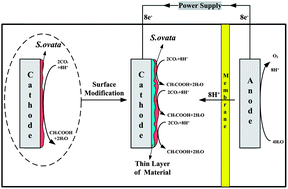Improved cathode materials for microbial electrosynthesis
Abstract
Microbial electrosynthesis is a promising strategy for the microbial conversion of carbon dioxide to transportation

* Corresponding authors
a
Department of Microbiology, University of Massachusetts, Amherst, Massachusetts 01003, USA
E-mail:
dlovley@microbio.umass.edu
Fax: +1 413-545-1578
Tel: +1 413-545-9651
b
Department of Polymer Science and Engineering, University of Massachusetts, Amherst, Massachusetts 01003, USA
E-mail:
russell@mail.pse.umass.edu
Fax: +1 413-577-1510
Tel: +1 413-545-2680
Microbial electrosynthesis is a promising strategy for the microbial conversion of carbon dioxide to transportation

 Please wait while we load your content...
Something went wrong. Try again?
Please wait while we load your content...
Something went wrong. Try again?
T. Zhang, H. Nie, T. S. Bain, H. Lu, M. Cui, O. L. Snoeyenbos-West, A. E. Franks, K. P. Nevin, T. P. Russell and D. R. Lovley, Energy Environ. Sci., 2013, 6, 217 DOI: 10.1039/C2EE23350A
To request permission to reproduce material from this article, please go to the Copyright Clearance Center request page.
If you are an author contributing to an RSC publication, you do not need to request permission provided correct acknowledgement is given.
If you are the author of this article, you do not need to request permission to reproduce figures and diagrams provided correct acknowledgement is given. If you want to reproduce the whole article in a third-party publication (excluding your thesis/dissertation for which permission is not required) please go to the Copyright Clearance Center request page.
Read more about how to correctly acknowledge RSC content.
 Fetching data from CrossRef.
Fetching data from CrossRef.
This may take some time to load.
Loading related content
